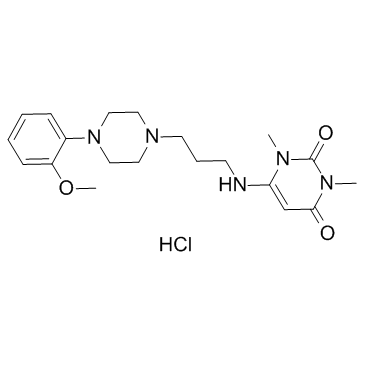Facilitation of expulsion of ureteral stones by addition of α1-blockers to conservative therapy.
Kenji Ohgaki, Kazutaka Horiuchi, Norio Hikima, Yukihiro Kondo
文献索引:Scand. J. Urol. Nephrol. 44(6) , 420-4, (2010)
全文:HTML全文
摘要
An antispasmodic agent and a medicine that facilitates stone expulsion are given commonly as conservative therapy for ureteral stones in Japan. The goal of this study was to compare the efficacy of the addition of various α(1)-blockers to the conservative therapy for spontaneous passage of ureteral stones.The subjects were 132 patients with stones from the upper to the lower ureter who were randomly placed into one of four groups and followed for 1 month to assess spontaneous passage of stones. The control group received daily doses of 240 mg flopropione as an antispasmodic agent and 1350 mg extract of Quercus salicina Blume/Quercus stenophylla Makino as a medicine that facilitates stone expulsion. The other three groups received this therapy and daily doses of 30 mg urapidil, 0.2 mg tamsulosin or 50 mg naftopidil, respectively. The characteristics of the stones and stone expulsion were evaluated by urinalysis, a kidney, ureter and bladder (KUB) X-ray, ultrasound and computed tomography.All patients completed the study and there were no major side-effects. There was no difference in age, stone position or stone size among the groups. Multivariate analysis using a Cox proportional hazards model indicated that the probability of stone expulsion for 1 month was increased 2.38 times (95% confidence interval 1.23-4.61) by naftopidil compared with control therapy alone (p = 0.01).Naftopidil in combination with an antispasmodic agent and a medicine that facilitates stone expulsion produces a significantly increased rate of ureteral stone expulsion.
相关化合物
| 结构式 | 名称/CAS号 | 分子式 | 全部文献 |
|---|---|---|---|
 |
盐酸乌拉地尔
CAS:64887-14-5 |
C20H30ClN5O3 |
|
Capillary electrophoresis with end-column electrochemilumine...
2015-12-01 [J. Chromatogr. B. Analyt. Technol. Biomed. Life Sci. 1006 , 146-50, (2015)] |
|
[Hypertensive crisis in cardiology: place of urapidil].
2012-01-01 [Kardiologiia 52(1) , 86-90, (2012)] |
|
Urapidil, a dual-acting antihypertensive agent: Current usag...
2010-07-01 [Adv. Ther. 27(7) , 426-43, (2010)] |
|
Effects of α1-adrenoceptor antagonists on phenylephrine-indu...
2012-03-15 [Eur. J. Pharmacol. 679(1-3) , 127-31, (2012)] |
|
Synthesis of a quinazoline derivative: a new α₁-adrenoceptor...
2011-10-01 [Bioorg. Med. Chem. Lett. 21(19) , 5905-9, (2011)] |